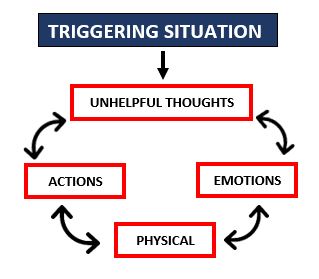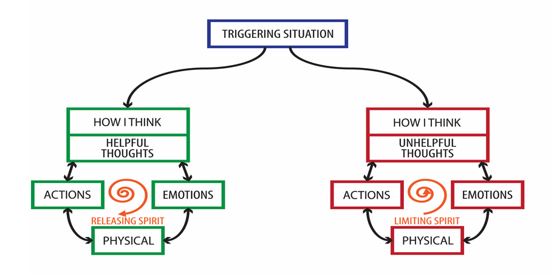Holistic Cognitive Behaviour Therapy: unleashing the human psyche and spirit
Dr Hilary Garraway explores Holistic Cognitive Behaviour Therapy (HCBT), a new strengths-based, solution-focused and creative model, fully recognising the importance of identity, the human spirit, and the potential within.

‘Something inside so strong’
When things get tough in life, what keeps you going and what gives you the determination to not give up? What dreams do you have for your life and what things energise you and make you feel that life is worth living? These sort of questions tap into our inner strengths and resources as well as the sense of purpose and hope deep within us. As Labi Siffre once sang, it’s about connecting with ‘something inside so strong.’
Each of us is a unique individual and each of us has a different combination of strengths, characteristics, interests and goals. Life’s journey is partly about finding out who we are and discovering how that unique individuality can be expressed so that life feels energising and has direction. It is about exploring such questions as ‘who am I?’, ‘where do I belong?’, ‘why am I here?’ and ‘where am I going in life?’
These questions are about our identity, values, belonging and purpose. By exploring these areas, it can connect us to an inner powerhouse of potential and a catalyst for change and yet these topics of conversation are not routinely explored within therapy and mental health services.
- See also: 'You can’t stop the waves, but you can learn to surf: Acceptance and Commitment Therapy'
- See also: 'Rules for living - what is Cognitive Behavioural Therapy?'
Holistic CBT
I’ve worked in the field of therapy for over 30 years, in various settings and using a range of therapeutic approaches. However, the model I find most useful is the CBT approach (Cognitive Behaviour Therapy) and this is one of the main therapies offered in the NHS. When a person comes for therapy, such as within NHS mental health services, the focus is often on reducing symptoms, for example, being less depressed or less anxious. CBT offers a useful framework to help identify unhelpful ways of thinking and behaving that maintain psychological difficulties and it offers useful strategies to make positive changes. However, over the years of working in this way with clients, I have been developing a more holistic CBT approach. This approach explores areas of a person’s life, such as those mentioned above, that are in danger of getting lost within this standard CBT process.
This has led to four main additions to the CBT model which are:
- People’s strengths and potential – what we chose to focus on is what is reinforced. So by exploring people’s strengths in therapy and not just their difficulties, it can help them to identify and visualise a better version of themselves. We can help people to recognise strengths or dreams that they have hidden away due to knockbacks and abuse in life. They can also develop a greater ability to hear their own inner voice of wisdom that knows what is best for them and to trust this more in making decisions.
- People’s context – it is important to not see a person in isolation. There is a danger with some basic approaches to CBT that the person and their difficulty is discussed out of their own personal context. This style of CBT is therefore in danger of implying that a person just needs to change their thoughts and behaviours and then life will be OK. Instead it is important to see the wider context and validate a person’s experiences and reactions, recognising that we are influenced by so many external pressures. These may include environmental, social and cultural influences such as inadequate housing, street violence, racism and homophobia and the influence of social media and various sub cultures. Therapy needs to acknowledge these contextual factors.
- People’s spirituality – this is about what energises us, what make us feel that life has purpose and meaning and what gives us hope. It can be about a sense of belonging and meaningful relationships such as connecting with other people, with nature and with the transcendent flow of life – being part of something bigger than ourselves. For some people, their spirituality maybe a connection to a faith tradition and/or with a cause that they believe in such as climate change or caring for the more vulnerable and marginalised in society.
- People’s identity –therapy is not just about reducing symptoms and solving problems but about helping a person to develop as a whole person. By understanding themselves better, they are able to connect with others who are on a similar journey and find a sense of belonging as well as connecting with life purposes that fit with their values and beliefs. As someone has said within the Open Dialogue approach, it’s not about asking ‘What is the matter with you?’ but asking ‘What matters to you?’
- See also: 'The examined life and the work of psychoanalysis'
- See also: 'Inner citadels: How to live the meaningful life of a Roman emperor'
Human spirit
I am grateful to the many clients over the years, who have helped to shape my thinking and have shared this journey to form what I now call Holistic CBT. This model still uses all of the ideas and strategies of standard CBT but I have added at the heart of it, the concept of the human spirit. This is a concept that really interests me and I am curious to know how different people define or identify with it.
How would you describe the human spirit? Maybe just pause your reading for a moment and consider that question.
Having asked that question to various groups and individuals over the years, it has been interesting to discover how people connect with this concept and are able to define it for themselves. Some of the terms that people use to describe our human spirit are that it is a person’s heart or core of who they are, their essence, true self, inner resolve, their soul that lives on after death, inner wisdom, their energy or aura, a higher level of consciousness, a connection to ancient wisdom and our shared humanity, to name but a few.
There seems to be something within each of us that is more than just our emotions, thoughts, physical sensations and behaviours, which are the four factors usually explored in standard CBT. By adding the idea of the spirit into CBT and also by looking at helpful patterns as well as unhelpful patterns we can add further dimensions to routine CBT cycles. For example, Figure 1 shows a standard, generalised CBT cycle and Figure 2 shows the same cycle using the Holistic CBT approach.
Figure 1 Standard CBT cycle


Figure 2 Holistic CBT cycle



As you can see, when we add the idea of the human spirit into the mix we can see that unhelpful cycles (in red) limit who we truly are and our potential and helpful cycles (in green) do the opposite, and free us to be who we are. This model also highlights how the spirit can be a strength to help us to change. As we connect to that inner strength within us then it helps us to move into more helpful ways of being.
Free to be Me
I have used this Holistic CBT model to develop a personal developmental course called ‘Free to be Me’ which is a 16-week programme. Therapy can be done in various ways and sitting in a room talking is one way, but I also think we can be a lot more creative in how we offer therapy. So this course uses ideas from art therapy, positive psychology, ecotherapy and various other sources. It also uses creativity such as reflective writing, clips from films, music and imagery.
The course is done in a group because I believe that peer support is one of the most powerful catalysts for change. Often the most painful experiences in life are due to difficulties in relationships and pain caused by others. So it, therefore, makes sense that the most powerful antidote to broken relationships is healthy and nurturing relationships.
Holistic CBT also highlights the importance of how we do therapy; it’s not just what we offer but how we offer it that can make the difference. Therapists who recognise that they are also on a journey of personal development are more likely to show empathy to others and will encourage mutual learning, celebrate diversity and encourage individuality.
So, what keeps you going and what gives you the determination to not give up? For me, it is a number of things but one of them has been to write a book on Holistic CBT and to share these ideas with others. Pavilion has published both the Holistic CBT book as well as the Free to be Me course manual to enable others to use this approach and to run the course. If you are interested to know more or wish to get in touch then please do so at www.hcbt.co.uk
Wanting to hear more about Holistic Cognitive Behaviour Therapy? The guide and companion course manual 'Free to be Me', published by Pavilion Publishing, explores the new strengths-based, solution-focused and creative model, exploring both identity and the potential within.
Comments
Write a Comment
Comment Submitted